Olof Verelius e la testimonianza delle pietre runiche nelle Notæ alla Hervarar Saga
DOI:
https://doi.org/10.14672/fg.v12i.2543Abstract
In the notes to his edition of Hervarar saga (Hervarar saga på Gammal Götska, Upsalæ 1672), Olof Verelius, the first (and only) professor of national antiquities at Uppsala University, often refers to Swedish (occasionally Danish) runestones among the various other literary, historical and juridical sources from classical antiquity and medieval times that he knows of. This paper investigates how he approaches the study both of the Icelandic sagas (§§ 1-2) and of the runes (§ 3), within the cultural background and academic milieu of seventeenth-century Sweden. In particular, present analysis focuses on the one hand on Verelius’ strategies in dealing with the inscriptions as reliable evidence of Old Scandinavian traditions, on the other on the external and runological data he can rely on, in order to assess to what extent his expositio is the result of sound – if dated – runographic issues or mere Gothicist propaganda (§§ 4-5). Investigation of some of the runestones dealt with in the Notae shows that, even within the cultural trend of his time, Verelius has pioneered the current analytical process of reading Viking Age inscriptions in context, and has occasionally determined the future critical discussion of single inscriptions.
Pubblicato
Fascicolo
Sezione
Licenza

Questo lavoro è fornito con la licenza Creative Commons Attribuzione - Condividi allo stesso modo 4.0.
CC-BY-SA



